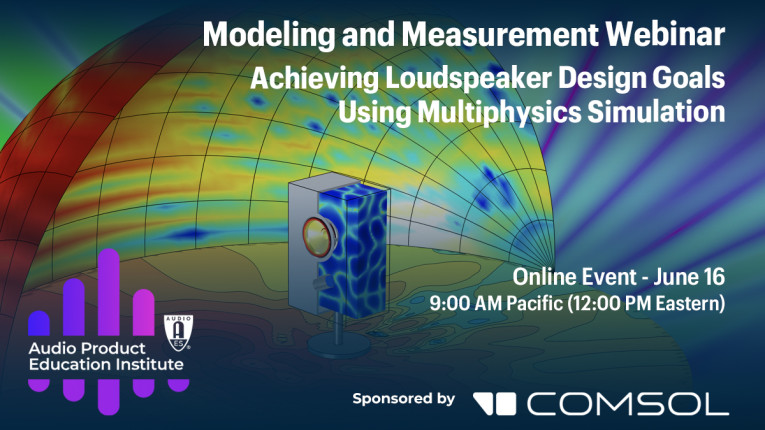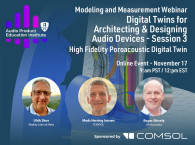
In this Audio Product Education Institute (APEI) webinar, Dolby Laboratories and COMSOL will discuss one of hottest topics currently for transducer and loudspeaker design, which is how to combine and integrate modeling, simulation and measurements in the development and evaluation process. Attendees to this online event will be able to hear from Lakshmikanth Tipparaju, a senior acoustic system and transducer engineer at Dolby Laboratories in San Francisco, as he shares project experiences of the design of a height channel speaker for immersive audio setups.
Tipparaju's role at Dolby focuses on simulation-driven development of acoustic systems and transducers to help expand adoption of Dolby Atmos in consumer products. His processes of simulation, measurements, and experiments helped to meet the design requirements, as modern home audio products are starting to feature integrated, upward-firing height channel speakers to create a fully immersive audio experience for consumers.
The presentation will provide an overview of design principles and the narrow radiation requirements for optimum height channel sound reproduction for home entertainment systems. This will be followed by a simulation case study discussing how acoustic modeling techniques can be used to guide the new height channel speaker concept development process to achieve the desired narrow radiation characteristics, while considering certain practical product integration constraints. The importance of validating acoustical models using experimental testing methods will also be briefly discussed in this presentation.
In a second talk, Jinlan Huang (COMSOL) will discuss more specifically the use of simulation in audio system design and the various numerical approaches to consider for multiphysics modeling of loudspeakers. Jinlan Huang is a lead applications engineer for vibrations and acoustics at COMSOL and instructs acoustics training courses, and she is in a unique position to explain the many reasons for audio product development teams to use simulation in their design process.
The presentation will explore how, in addition to shortening design cycles, simulation allows engineers to explore novel ideas and analyze performance before prototyping, as well as optimize new and existing products and study how a device will interact with its future environment. Through examples and demonstrations, attendees will receive insight into the modeling techniques available for loudspeaker simulations and learn the strategies required in order to obtain the full frequency range response of the system, as well as appropriate post-processing tools that provide a fully virtual testing environment.
The Audio Product Education Institute (APEI) was launched in January 2020, as an initiative of the Audio Engineering Society (AES), to focus on promoting methodologies, practices and technologies involved in developing and bringing audio products to market. www.AES.org.
APEI Modeling and Measurement Webinar
Achieving Loudspeaker Design Goals Using Multiphysics Simulation
Wednesday, June 16, 2021 - 9:00 AM Pacific (12:00 PM Eastern)
www.audioproducteducationinstitute.org/achieving-loudspeaker-design-goals-using-multiphysics-simulation/







